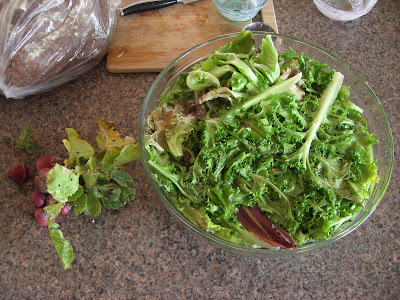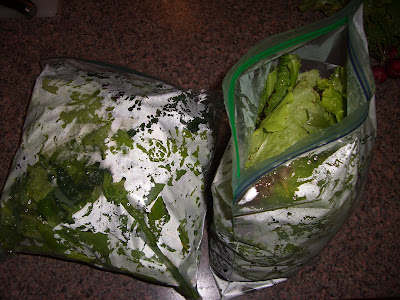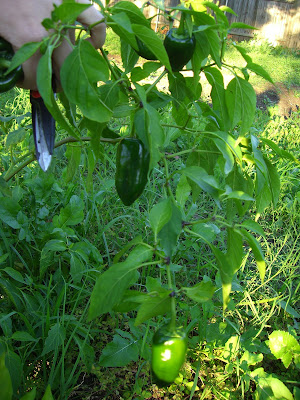Jenny took this picture while we were walking with Josephine, my mom and grandmother down my home-street over the holidays (over Thanksgiving, actually), but it didn't meet her journalistic standards, so I thought I'd share it b/c it's pretty (stereo)typical. I like it, though . . .

I was still getting a smattering of produce in December, including the round Texas Moschato squash that I promised to show you a couple posts back. It was delicious. My yellow squash has a decent flavor, but this Moschato squash has a really sweet, nutty flavor that puts the standard yellow squash to shame. In terms of flavor, I'd say it's something halfway between a yellow crookneck squash and a butternut squash.

And it's fairly indicative of the kind of winters we have here when you see I was still picking some peppers and watermelon in December. This was the last of them -- I picked them b/c we were expecting a hard freeze later that night.

I've never really been organized enough to worry about saving seeds, but I did some of that this year, including the seeds from the Texas Moschato squash that I'm going to try to replant in the spring:

I made a quick harvest of the lettuce and radishes before we left on our Christmas-time trip to see our families (I was a little paranoid that the weather would get too cold for them while I was gone, so I wanted to take what I could), and it lasted me for the full week or so that we were gone. Of course, the plants were still here when we got back . . . it must take some really low temperatures to do in lettuce.
Getting away from the garden . . . I had some leftover beef jerky, and I didn't figure I'd have an occasion to eat it straight anytime soon, so I blended it up into something finer that I could use to season things -- think "beef salt":

I haven't tried the "beef salt" yet, but if the rich, peppery, earthy smell that wafted out of the blender after 30 seconds of pulsing is any indication, it's going to be amazing.

We had nice weather for a cookout on New Year's Eve, so I did some TX gulf shrimp and burgers.

Let me address the burgers. I don't do them a lot, certainly not frequently enough to have it down to a perfect art. But a while back, I read an article or two about "gourmet" burgers, and some of the advice was to seer them in a skillet before transferring them to an oven or grill to finish.
Before all that, though, I had to make the patties. In one of those articles I mentioned, I also read that brisket makes some of the best hamburgers. (One of the chefs quoted in the article said it was his favorite kind of ground beef for burgers). I'd never heard of grinding brisket before that, but it seemed to make sense. And sure enough, I went to Central Market and asked for them to grind up half a brisket for me, bringing home 6 lbs of ground brisket and freezing most of it for future use.
For the New Year's Eve burgers, I mixed about 2/3 lb ground brisket with some seasoning and duck fat from Kocurek Family Charcuterie (also a tip I'd read in one of the articles). Of course, there was already a decent amount of marbling from the brisket itself -- this wasn't going to be super-lean ground beef -- so adding duck lard made it that much more terrifying. Honestly, they still didn't end up quite as fatty or juicy as I had expected. Next time, more lard!
I heeded the advice about seering in the cast iron pan first, and I obviously wanted the smoke from the grill rather than the raw gas heat of the oven. In addition to the oak I was burning in the smoker, I added some rosemary after shaping/pruning one of my bushes.

On to the other ingredients. The Wednesday market has been lacking in cheese options lately -- the woman who normally brings goat cheese hasn't been there. That's a convenient excuse for me, because when it comes to quality, I can go to the grocery store and get better options imported from elsewhere in the US and Europe.
In particular, I tried a Morbier a few months ago. When I asked for a smelly cheese at Central Market, they recommended it, and I liked it. Since I had been toying with ingredients for a fancy burger in the back of my mind for the last few months, it seemed like it'd be a good match, and I was more than a little pleased with myself when I later read a
review of the recently opened DBGB, where Daniel Boulud (or one of his cronies) is also adding Morbier to the burgers. The excerpt:
"Here the burger comes plain if you like, or topped with pork. The best option is the coarsely named Frenchie, which arrives as if a passenger on an old Cunard ship, with confitted pork belly, arugula, tomato-onion compote and a slab of Morbier, riding a peppered brioche bun with cornichons and mustard on the side."
So they have a lot of other great ingredients that I didn't have for my burger (I'd especially would've liked that bun.), but I enjoyed the coincidence nonetheless.
In addition to the Morbier, my contributions to the burger were the Pickled Green Tomatoes from Lightsey Farms I'd gotten for Christmas (they did double duty as both the burgers' tomatoes and pickles) and some mixed lettuces with diced green onion mixed in.

This is where the story takes a disappointing turn. Everyone knows that a good bun plays a big role in making a good burger, but I didn't buy any while I was out getting the other ingredients. So my big-time burger quickly became a patty melt. But it was a fun exercise all the while. The final product is below (including a condiment I "made" mixing Duke's Mayonnaise with ketchup).

And last of all, here's a drink I mixed up with some of
my peach shrub, and from the backyard, a hot pepper and rosemary . . .

It was a fine New Year's.

 Another bowl of lettuce from after we got back from the Christmas trip:
Another bowl of lettuce from after we got back from the Christmas trip: Found this in the lettuce . . .
Found this in the lettuce . . . I don't know what it is, but I've really been a crock-pot fiend lately. I started off with a great bison roast from Thunderheart Bison, a Richardson Farms pork shoulder, and then this duck breast from Countryside Farms. (South) Texas oranges have been in season for 2-3 months now and I was needing to use some that Jenny brought from HEB a while back. (Incidentally, I already had a ton of tangerines that I was eating from Orange Blossoms Farm in Carrizo Springs [also South TX . . . the "Wintergarden region"]. I added green onions, olive oil, stock and a healthy dose of seasoning.
I don't know what it is, but I've really been a crock-pot fiend lately. I started off with a great bison roast from Thunderheart Bison, a Richardson Farms pork shoulder, and then this duck breast from Countryside Farms. (South) Texas oranges have been in season for 2-3 months now and I was needing to use some that Jenny brought from HEB a while back. (Incidentally, I already had a ton of tangerines that I was eating from Orange Blossoms Farm in Carrizo Springs [also South TX . . . the "Wintergarden region"]. I added green onions, olive oil, stock and a healthy dose of seasoning. I threw in carrots and cabbage towards the end. Both the duck and vegetables were great; it's hard to beat roast pork, though.
I threw in carrots and cabbage towards the end. Both the duck and vegetables were great; it's hard to beat roast pork, though. Before I take anything else from the garden (mainly leafy stuff is all that remains), I'm letting it recover from my latest harvest and some particularly harsh weather (down in the teens) that we got a few weeks ago. So I've had some free time to finally start tackling the weeds, and Josephine took an interest in collaborating on the project. The weather was beautiful -- you really don't get continously cold weather around here until January or February. (The cold snaps are sporadic before that, starting around October and continuing well through the holidays, with short-wearing weather not at all unusual at Christmas time). And even in January and February, you there are usually some very mild, sunny afternoons.
Before I take anything else from the garden (mainly leafy stuff is all that remains), I'm letting it recover from my latest harvest and some particularly harsh weather (down in the teens) that we got a few weeks ago. So I've had some free time to finally start tackling the weeds, and Josephine took an interest in collaborating on the project. The weather was beautiful -- you really don't get continously cold weather around here until January or February. (The cold snaps are sporadic before that, starting around October and continuing well through the holidays, with short-wearing weather not at all unusual at Christmas time). And even in January and February, you there are usually some very mild, sunny afternoons. Here she is on the hunt . . . I'm hoping she develops truffle-sniffing abilities:
Here she is on the hunt . . . I'm hoping she develops truffle-sniffing abilities:













 I made a quick harvest of the lettuce and radishes before we left on our Christmas-time trip to see our families (I was a little paranoid that the weather would get too cold for them while I was gone, so I wanted to take what I could), and it lasted me for the full week or so that we were gone. Of course, the plants were still here when we got back . . . it must take some really low temperatures to do in lettuce.
I made a quick harvest of the lettuce and radishes before we left on our Christmas-time trip to see our families (I was a little paranoid that the weather would get too cold for them while I was gone, so I wanted to take what I could), and it lasted me for the full week or so that we were gone. Of course, the plants were still here when we got back . . . it must take some really low temperatures to do in lettuce. 

 I haven't tried the "beef salt" yet, but if the rich, peppery, earthy smell that wafted out of the blender after 30 seconds of pulsing is any indication, it's going to be amazing.
I haven't tried the "beef salt" yet, but if the rich, peppery, earthy smell that wafted out of the blender after 30 seconds of pulsing is any indication, it's going to be amazing. We had nice weather for a cookout on New Year's Eve, so I did some TX gulf shrimp and burgers.
We had nice weather for a cookout on New Year's Eve, so I did some TX gulf shrimp and burgers.

 Let me address the burgers. I don't do them a lot, certainly not frequently enough to have it down to a perfect art. But a while back, I read an article or two about "gourmet" burgers, and some of the advice was to seer them in a skillet before transferring them to an oven or grill to finish.
Let me address the burgers. I don't do them a lot, certainly not frequently enough to have it down to a perfect art. But a while back, I read an article or two about "gourmet" burgers, and some of the advice was to seer them in a skillet before transferring them to an oven or grill to finish. 
 On to the other ingredients. The Wednesday market has been lacking in cheese options lately -- the woman who normally brings goat cheese hasn't been there. That's a convenient excuse for me, because when it comes to quality, I can go to the grocery store and get better options imported from elsewhere in the US and Europe.
On to the other ingredients. The Wednesday market has been lacking in cheese options lately -- the woman who normally brings goat cheese hasn't been there. That's a convenient excuse for me, because when it comes to quality, I can go to the grocery store and get better options imported from elsewhere in the US and Europe. 


 I added Round Rock honey:
I added Round Rock honey: And after letting it steep in hot water for a few minutes to dissolve the honey and get out the taste of the mint, I added ice and some leftover lemon juice I had from something else
And after letting it steep in hot water for a few minutes to dissolve the honey and get out the taste of the mint, I added ice and some leftover lemon juice I had from something else 
 Also, here's some cauliflower from the farmer's market. I'm not sure why I took this picture. The veg. was good, but I have a hard time seeing how a picture of it conveys anything other than something completely boring. I'll use it to illustrate another point, though: whenever I cook any meat products involving bones, I always make a stock out of the leftovers before throwing out the bones. You might have heard elsewhere that homemade stock is a really easy way to give food more flavor -- and I'd agree with that. It really is hard for store-bought stock to compete with it. And all it takes is setting the bones, fat, etc. in water to boil for however long you want, then freezing the leftovers. As long as you've got room in your freezer, it's hard to think of a reason not to squeeze as much out of the meat and bones as you can.
Also, here's some cauliflower from the farmer's market. I'm not sure why I took this picture. The veg. was good, but I have a hard time seeing how a picture of it conveys anything other than something completely boring. I'll use it to illustrate another point, though: whenever I cook any meat products involving bones, I always make a stock out of the leftovers before throwing out the bones. You might have heard elsewhere that homemade stock is a really easy way to give food more flavor -- and I'd agree with that. It really is hard for store-bought stock to compete with it. And all it takes is setting the bones, fat, etc. in water to boil for however long you want, then freezing the leftovers. As long as you've got room in your freezer, it's hard to think of a reason not to squeeze as much out of the meat and bones as you can.







 In rough order, I add the onions, the poblanos, pork, the broth, the cumin and the hominy, and this is what I end up with . . .
In rough order, I add the onions, the poblanos, pork, the broth, the cumin and the hominy, and this is what I end up with . . . You have no idea all the wonderful smells that come with this as it's being prepared. The onions caramelizing, the pork fat cooking in the skillet, the musky cumin seeds toasted and ground, the peppers roasting, the fresh cilantro . . . it's all heaven. Once you've got a serving in a bowl, you garnish it with the pumpkin seeds, cilantro, and a heavy dose of "Queso fresco". They don't have queso fresco at the market, but I've found a goat feta from Maid in the Shade that works just as well.
You have no idea all the wonderful smells that come with this as it's being prepared. The onions caramelizing, the pork fat cooking in the skillet, the musky cumin seeds toasted and ground, the peppers roasting, the fresh cilantro . . . it's all heaven. Once you've got a serving in a bowl, you garnish it with the pumpkin seeds, cilantro, and a heavy dose of "Queso fresco". They don't have queso fresco at the market, but I've found a goat feta from Maid in the Shade that works just as well. So that was the delicious pozole.
So that was the delicious pozole. 



.JPG)
